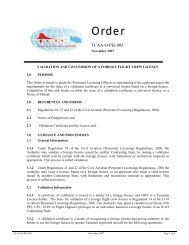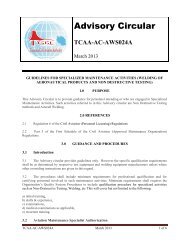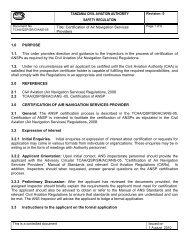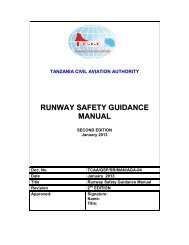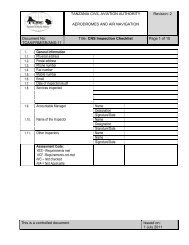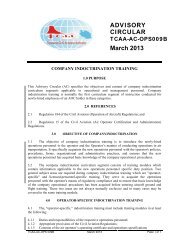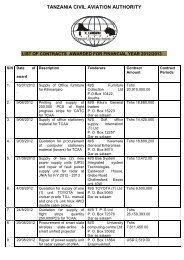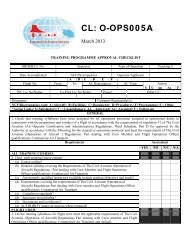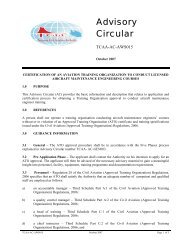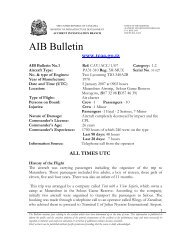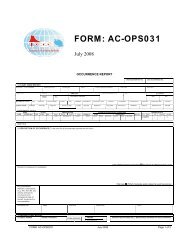AIB Bulletin No - Tanzania Civil Aviation Authority
AIB Bulletin No - Tanzania Civil Aviation Authority
AIB Bulletin No - Tanzania Civil Aviation Authority
- No tags were found...
You also want an ePaper? Increase the reach of your titles
YUMPU automatically turns print PDFs into web optimized ePapers that Google loves.
THE UNITED REPUBLIC OF TANZANIAMinistry of Communications & TransportTANZANIA CIVIL AVIATION AUTHORITYACCIDENT INVESTIGATION BRANCHOFFICE OF THE MINISTERACCIDENT INVESTIGATION BRANCHP. O. BOX 2819DAR ES SALAAME-mail: tcaa@tcaa.go.tzWebsite:www.aviationauthority.org<strong>AIB</strong> <strong>Bulletin</strong><strong>AIB</strong> <strong>Bulletin</strong> <strong>No</strong>. 2 Ref: CAV/CC/2/05 Category: 1.2Aircraft Type & Reg. Cessna 208B Reg.5H-PAF S/<strong>No</strong>. 208-0754<strong>No</strong>. & type of Engines:One PT6 114AYear of Manufacture: 1999Date and Time (UTC):3 March 2005 at 0950 hoursLocation: AirportNyamuhongoro Damp site, 9nm east of MwanzaAirport.Type of Flight:Scheduled flightPersons on Board: Crew - 1 Passengers - 9Injuries: Crew - Nil Passengers - NilNature of Damage:Damage to the fin and radio antennaCommander’s Licence:CPLCommander’s Age:38 yearsCommander’s Experience: 9265 hours of which 2900 were on typeLast 90 days 134 hoursLast 50 days 50 hoursInformation Source:Telephone call from the OperatorALL TIMES UTCHistory of the flight5H-PAF was operating Precisionair Flight PW 488 from Kilimanjaro to Mwanza with anintermediate stop at Shinyanga. The first sector of the flight was uneventful. The aircrafttook off from Shinyanga for the flight to Mwanza at 0925 hours. It was carrying one pilotand 9 passengers and was flying under visual flight rules. The cruising altitude wasFL065 and the estimated time of arrival at Mwanza was 0952 hours. At 0948 hours raisedthe Mwanza Tower and reported top of descent. He was given the relevant weatherinformation and cleared to runway 30.The pilot testified that when he was on the descending turn at 5500 feet (about1700 feetagl) to position himself on final runway 30, he encountered a flock of scavenger birds(Marabou Storks) that numbered more than 10. He performed gentle turns and altitudechanges in order to avoid them. As he did so, he suddenly saw one of the birds flyingdirectly towards the windscreen. He immediately dipped the nose to avoid the imminentcollision. However, the bird impacted the fin, causing an immediate yaw. He correctedthis with a left rudder input. He also noticed that the ball on the turn and slip indicatorhad moved fully to the right. He tried to trim the rudder to return the ball to the normalposition but the ball only traveled half the distance. The flap motor circuit breaker alsotripped and was reset by the pilot. However, the approach to land was continued and1
5H-PAF landed at Mwanza at 0956 hours.Damage to the aircraftInspections on the airframe showed damage to the fin about four feet from the top. Aboutone square foot of the skin on the port side of the fin had been torn open. Furtherexamination of the fin damage showed that three leading edge ribs and one main rib weredamaged. The main spar of the fin was found bent.The bird strikeThe bird strike occurred during descent when the aircraft was at about 1700 feet agl and 9nautical miles from the airfield. It was flying below the clouds.The accident area is above a fish waste damp site. Fish factories in Mwanza dispose theirwaste products at Nyamuhongoro damp site that is directly below the aircraft flight pathfor runway 12/30 of Mwanza airport. This damp site is a big attraction for scavengerbirds.There has been a number of bird strikes in the area. The corrective action taken was tobury the fish factory waste in the same area. This has since been implemented but thebirds have successfully excavated the fish waste. They have also multiplied in appallingproportions. In 2002 the number of birds resting in the area was estimated at between5 000 and 10 000. At the time of this accident the number of birds resting in the samearea was estimated at between 100 000 and 200 000.Marabou StorksWhile there are a number of scavenger birds in the Nyamuhongoro area, includingvultures, Marabou Storks represent the biggest potential source of danger to aircraftmovements. This is because of their large numbers and the fact that the Marabou Stork ismuch heavier than the other bird species.A male marabou stork can weigh up to 9 kg and stands up 1.5 metres tall. With awingspan of 2.9 metres, it is one of the largest flying birds in the world.The Marabou Stork is to be found throughout most of tropical Africa. They prefer opendry savannahs near large lakes or rivers. They are often found in around fishing villages,slaughter houses and rubbish damps. The growing cities of East Africa, notably thosearound the great lakes, have of late attracted many of these birds because of theincreasing loads of human waste. Indeed marabous save City Councils millions ofshillings in garbage collection – an attribute which gives them a major economic value.A Marabou Stork can eat up to 700 grams of garbage in one day. With an estimatedpopulation of 500 000 marabous around Mwanza, more than 300 tons of rubbish iscleared daily.Bird Control StrategyPrevious practices of removing the birds from the Nyamuhongoro area through buryingfish waste failed. The Mwanza Regional Health Officer promised to move the damp siteto another area (Nyegezi) which is outside the aircraft flight path. He also said that fish2
waste can be completely destroyed by incineration. As a matter of long term strategy, fishfactories around Mwanza, he said, will in future, be required to incinerate all fishremains.Bird strikes in the Mwanza area can be avoided by flying in the late evening hours or atnight. Most of the birds tend to rest during night hours.3



